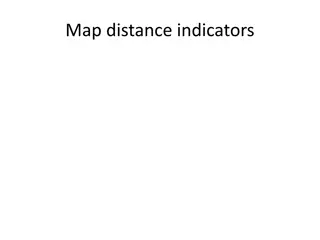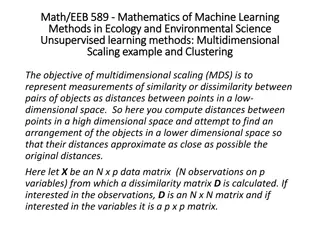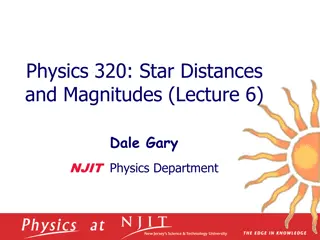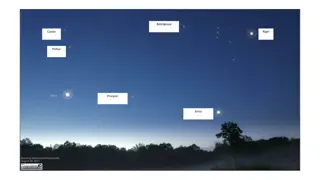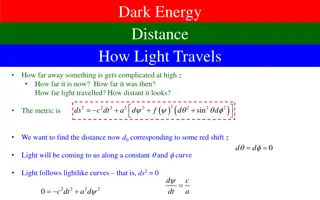Understanding Distances in Space
Exploring the vast distances in space through units like the Astronomical Unit (AU), Light Year (LY), and Parsecs, and understanding the intricacies of measuring these distances via the Distance Ladder. Delve into the fascinating world of cosmic scales and the uncertainty involved in determining distances within our universe.
Download Presentation

Please find below an Image/Link to download the presentation.
The content on the website is provided AS IS for your information and personal use only. It may not be sold, licensed, or shared on other websites without obtaining consent from the author. Download presentation by click this link. If you encounter any issues during the download, it is possible that the publisher has removed the file from their server.
E N D
Presentation Transcript
Distance Units - the AU An Astronomical Unit (AU) is defined as the average distance between the Earth and Sun. 1 AU = 92 955 807 miles or 149 597 871 km AU s are used to measure distances within the solar system. There are approximately 63,240 AU s in one light-year (LY).
Distance Units - the Light Year One light year (LY) is the distance light travels in one year. Light years are not used to measure time. A light year is a convenient unit to use for measuring distances within the galaxy, especially the distances to nearby stars. One LY = 5.88 trillion miles or 9.46 trillion km.
Distance Units - Parsecs A parsec is a shortened term for parallax second of arc . A star at a distance of one parsec shows a parallax angle of 1 second of 1 degree (1/3600 of a degree). This translates to a distance of 3.26 LY. Distances in parsecs are not commonly quoted, but diatances in kiloparsecs (kpc), megaparsecs (Mpc) or gigaparsecs (Gpc) are often used, especially when referring to distances to faraway galaxies. 1 kpc = 1000 pc = 3260 LY 1Mpc = 1 million pc = 3.26 million LY 1Gpc = 1 billion pc = 3.26 billion LY
The Distance Ladder Calculating distances in space is much like climbing a ladder: Each step higher relies on the previous step below, and the higher you go, the more uncertain you are about your stability.
The Distance Ladder Calculating distances in space is much like climbing a ladder: Each step higher relies on the previous step below, and the higher you go, the more uncertain you are about your stability . Knowing the distance to one object often serves as a stepping stone to determining the distance to another.
The Distance Ladder Calculating distances in space is much like climbing a ladder: Each step higher relies on the previous step below, and the higher you go, the more uncertain you are about your stability . Knowing the distance to one object often serves as a stepping stone to determining the distance to another. The most distant measurements are those with the highest degrees of uncertainties.
Preliminary Measurements The early Greeks had to first determine the diameters of the Earth and Moon before they could calculate a distance to the Moon. Eratosthenes performed the now famous experiment between Syene and Alexandria to determine the Earth s circumference, and thus its diameter. For a review of the details of the experiment, check out this link: http://dev.physicslab.org/Document.aspx?doctype=2&f ilename=IntroductoryMathematics_EarthCircumferenc e.xml
Earth Circumference A short excerpt of the Eratosthenes experiment from the Cosmos with Carl Sagan explains this idea: https://www.youtube.com/watch?v=G8cbIWMv0rI A teachers guide to replicate the activity is here: http://www.physics2005.org/projects/eratosthenes/Te achersGuide.pdf In order to really do this, you must find another school or observer that is along your line of longitude, and at a some distance away.
Size of the Moon Knowing the size of the Earth, Aristotle used observations from a lunar eclipse to get an estimate of the Moon s angular size. An interactive of this activity is at this link, but you can easily turn it into a pencil and paper activity: http://dev.physicslab.org/Document.aspx?doctype=2&file name=IntroductoryMathematics_SizeMoon.xml
Distance to the Moon Once Aristotle knew the Moon s diameter, he could calculate a distance to the Moon by using the property of similar triangles. (You may want to first ask students to experiment with different sized coins to see how far they have to move the coin away from their eye to get it to match the size of the Moon in the sky. (But even with a dime, this can be challenging.) The following activity suggests using a thumbnail, but using (the width of) a pencil works better: http://dev.physicslab.org/Document.aspx?doctype=2&filename= IntroductoryMathematics_EarthMoonDistance.xml
Distance to the Moon Once Aristotle knew the Moon s diameter, he could calculate a distance to the Moon by using the property of similar triangles
Distance to the Moon The Apollo XI. astronauts left a mirror on the lunar surface so that laser beams from Earth could be reflected back. The measurement of the incoming light gives a highly accurate measurement of the Moon s distance, which varies from 363,104 km 406,696 km, depending on where it is in its orbit. The link to the full story is here: http://science.nasa.gov/science-news/science-at- nasa/2004/21jul_llr/
Distance to the Moon The lunar laser ranging experiment is still operational and can determine the distance between Earth and Moon to a few centimeters. The McDonald Observatory in Texas operates the laser that bounces off the Moon. 16
Distance to the Sun Aristarchus http://galileoandeinstein.physics.virginia.edu/lectures/gkastr1.html When the Moon appears to be exactly half lit, the line from the Moon to the Sun must be exactly perpendicular to the line from the Moon to an observer on Earth. (See the figure below). So, if the quarter moon is observed during the day, one could measure the angle between the Moon and the Sun in the sky (the angle in the figure). You can then construct a long thin triangle, with its baseline the Earth-Moon line, having an angle of 90 degrees at one end and at the other, and so find the ratio of the Sun s distance to the Moon s distance. This may be solved using either trigonometry or a scale drawing.
Distance to the Sun scale drawing The Earth-Moon distance is 384 400 km (adjacent side). Use a scale of 1 cm = 100 000 km for your drawing. Use a protractor to create angles of 90 and 89.8 on the drawing. Draw out the opposite and hypotenuse sides until they intersect. From that point, draw a straight line back to the adjacent side to represent the Earth-Sun distance. Measure this in cm and convert it to km to get the distance from Earth to the Sun.
Distance to the Sun more to come There wasn t any good way to determine a more accurate distance to the Sun until after Kepler had derived his three laws of planetary motion, so we will come back to this idea once Kepler s Laws have been examined. Sneak preview: In 1677, English astronomer Edmond Halley proposed a method for calculating the Earth s distance from the Sun by using the transit of Venus. Halley died 19 years before his method could be attempted and proven successful (during the 1761 transit of Venus).
Keplers Third Law Johannes Kepler derived three laws of planetary motion, which revolutionized how astronomers understood the solar system. His third law, published in 1618, gave a way to measure the relative distance of a planet from the Sun: P2 = A3 where P = planet's orbital period in years and A = the planet s average distance from the Sun, in AU Example: Venus orbits the Sun in .615 Earth years. What is its distance from the Sun? .6152 = A3 A= .723 AU
A Transit of Venus A Venus transit is when Venus crosses exactly between Earth and the Sun. The silhouette of the planet may be viewed moving across the solar disc, like a miniature eclipse. This alignment is rare, coming in pairs that are eight years apart but separated by over a century. The most recent transit of Venus was in June of 2012. The next transit of Venus pair occurs in December 2117 and 2125.
Distance to the Sun - transit of Venus - 1 http://www.exploratorium.edu/venus/question4.html Imagine two different people, at two different locations on Earth, viewing the transit of Venus. The angle between the two different paths measured from Earth is angle E:
Distance to the Sun - transit of Venus - 2 From Kepler's third law, we know the relative distances of all the planets from the Sun. Case in point: We know that Venus's distance from the Sun is 0.72 times the Earth's distance from the Sun. This distance relationship also tells us angle V, the angle between the two paths as seen from Venus: angle V is angle E divided by 0.72. (This is true only for small angles, which these are.)
Distance to the Sun - transit of Venus - 3 In addition to angle V, we also need to know the distance between the two observers on Earth, at points A and B. Call this distance dA-B. For small angles, tan (1/2 A) = 1/2 tan A, so the distance between Earth and Venus is equal to dA-B / tan V. Note that this gives only the distance to Venus, not to the Sun.
Distance to the Sun - transit of Venus - 4 If we have the distance between Earth and Venus, then the distance from Earth to the Sun may be calculated by a simple ratio: Venus distance .72 AU 107,000,000 km = 1.0 AU x km distance Earth *X= 148,600,000 km *This was the distance between Earth and Sun at the time of the 2012 transit. The average distance between Earth and Sun is 149,597,871 km.
Distance from Radar In modern times, radar has been used to measure distance to the inner planets and asteroids, as well as comets. The Arecibo radio telescope in Puerto Rico is one of the instruments that is used for these studies. The Arecibo telescope has the capability to transmit a high powered-beam of radio waves, as well as to detect their returning echoes.
Distance from Radar Although radar may be used to determine distances, its primary function is to create maps of planetary surfaces and to determine the shapes of asteroids and comet nuclei. Radar image of the Moon s south polar region.
Parallax The parallax technique is used to measure the distances to nearby stars, out to about 500 LY. (The more distant stars have such small motions that an accurate parallax angle cannot be determined for them.) The baseline of Earth s orbit is used to measure the parallax angle. This is the angular amount of perceived shift of the nearby star against the backdrop of the distant stars.
Parallax and Parsces There is a simple relationship between a star's distance and its parallax angle: d = 1/p The distance d is measured in parsecs and the parallax angle p is measured in arcseconds. This relationship is why many astronomers prefer to measure distances in parsecs.
Star Magnitudes Many of the subsequent distance techniques rely on knowing star magnitudes. There are two types: Apparent (m) and Absolute (M) Apparent magnitude is how bright the star appears from Earth. Absolute magnitude is how bright the star would appear if placed at a distance of 10 parsecs. So if m < M, the star would be closer than 10 parsecs. Both magnitude scales work the same way: the more negative the number, the brighter the star. The Sun has an absolute magnitude of 4.74 and an apparent magnitude of -26.7.
Spectroscopic Parallax - definition Spectroscopic parallax is a sort of misnomer, because there is no measurement of a shift in position, as there is in (trigonometric) parallax. The use of the word parallax in this instance refers to using a star s spectrum to find its distance. This technique can be applied to any star, assuming that its apparent magnitude has been measured and a spectrum has been recorded.
Steps for Spectroscopic Parallax 1. The pattern of spectral lines assigns a spectral class to the star, giving it a horizontal position on an H-R diagram.
Steps for Spectroscopic Parallax 2. The thickness of spectral lines is used to assign a luminosity class to the star, giving it a vertical position on an H-R diagram.
Steps for Spectroscopic Parallax 3. From its location on H-R Diagram, an absolute magnitude can be estimated. This links to an applet that may be used to demonstrate these steps: http://astro.unl.edu/naap/distance/anim ations/spectroParallax.html
Steps for Spectroscopic Parallax 4. The distance modulus equation can then be used to calculate the distance to a star: where d is the distance in parsecs, m is the apparent magnitude of the star and M is the absolute magnitude of the star d = 10(m - M + 5)/5 Calculating spectroscopic parallax is one of the most important applications of the H-R Diagram.
The Distance Modulus In addition to the equation, the distance modulus can be easily applied through the use of a nomogram. Draw a straight line connecting the two magnitudes of a star (M and m). The distance may be read from where the line crosses the middle axis. 36
Standard Candles Some objects in space have fixed and known absolute magnitudes, and can be used to determine distances by using the distance modulus. Since their intrinsic brightness is known, their apparent magnitude is directly an effect of distance. Think of it like a 100W light bulb: As the distance between you and the light bulb doubles, the brightness drops off according to the inverse-square law: Brightness = 1/d2 Doubling the distance makes the light bulb appear of its original brightness.
Examples of Standard Candles Here are some celestial objects that are used as standard candles: Cepheid and RR Lyrae variable stars Type Ia supernovae Spiral galaxies with measured rotational velocities (Tully-Fisher relationship) Gravitationally-lensed quasars There are other standard candles that are measured using radio or x-rays wavelengths.
Cepheid variable stars Cepheid variable stars may be used to measure the distance to a star cluster or nearby galaxy. This technique is good out to distances of 60 million LY. They obey a well-defined period-luminosity relationship, discovered in the early 1900 s by the Harvard astronomer Henrietta Leavitt. This is now known as the Leavitt Law. Other types of variable stars were subsequently discovered with similar patterns, such as RR Lyrae variables.
Cepheid variable stars To find the distance to a Cepheid variable star, one must first observe its brightness fluctuations over time and plot a light curve. Then its period and average magnitude may be calculated. This plot shows a star with a period of 5 days and an average apparent magnitude of 15.6:
Cepheid variable stars Cepheid variable stars obey a well-defined period- luminosity relationship: The luminosity can be converted to an absolute magnitude, and the distance modulus equation is then used to calculate distance.
Star Cluster Fitting Another way to use the H-R Diagram to calculate distance is to fit the main sequence of a star cluster to a model or standard star cluster. In this method, it is assumed that all the stars of a cluster are at the same distance away, so when it is fitted, the distance to the cluster is determined. The model cluster contains stars whose distances are known from parallax and therefore have defined absolute magnitudes.
Star Cluster Fitting In this example, a star cluster is plotted (grey dots) against the model track of a known star cluster (red). The vertical distance is adjusted between the two main sequences so that they overlap. The stars in this cluster show dimmer apparent magnitudes, so this cluster must be farther away than the model cluster.
Star Cluster Fitting The vertical distance is adjusted between the two main sequences so that they overlap. The difference ( m) may be used in the distance modulus equation as a substitute for (M-m): d = 10(( m) + 5)/5 where d is the distance in parsecs between the two clusters In the previous example, the m was 5.4 magnitudes, so d = 10((5.4) + 5)/5 = 102.08= 120 parsecs If the model cluster had a known distance of 80 pc, then the fitted cluster distance is 80 + 120 = 200 pc.
Star Cluster Fitting Here s an interactive activity: http://astro.unl.edu/naap/distance/animations/clusterFittingExplorer .html
Supernova Type Ia light curves The light curves from Type Ia supernovae may be used as distance indicators to distant galaxies by using a variation of the distance modulus equation: d = 10 (m-M+5)/5 Where distance (d) is the distance in parsecs, m is the peak apparent magnitude of the supernova and M is the average absolute magnitude of all standard candle Type Ia supernovae, equal to -19.3.
Supernova Type Ia light curves As more data from SN light curves accumulated, it was realized that not all Type Ia SN behaved exactly alike. Below is a refinement technique introduced by Mark Phillips in 1993. There s a correlation between the peak brightness of the supernova and the rate at which its brightness declines over a 15 day period after maximum light in the B (blue filter) band. It is known as the luminosity-decline relation: Brighter SN fade more slowly, and fainter ones more rapidly. The change in blue magnitude in the 15 days following maximum light is m15.
Galaxy redshifts Most galaxies show a shift in their spectral lines towards longer (redder) wavelengths. This is primarily due to the expansion of the universe. By measuring the amount of the shift, the line-of-sight velocity and distance to the galaxy may be calculated using Hubble s law.
Measuring galaxy redshifts The first step in the procedure is to measure the displacement of certain spectral lines from their original (rest) position. The rest wavelength is the laboratory position of the line. The displaced position will be called the observed wavelength. The redshift (Z) is calculated by this equation: Z = (observed wavelength/ rest wavelength) - 1 Note: Z should be a positive number
Galaxy velocity from redshift Once Z is known, the velocity (v) in km/sec may be calculated by using this equation below: c (the speed of light) = 3.0 x 105 km/sec v = (Z + 1)2 -1 c = (Z + 1)2 +1
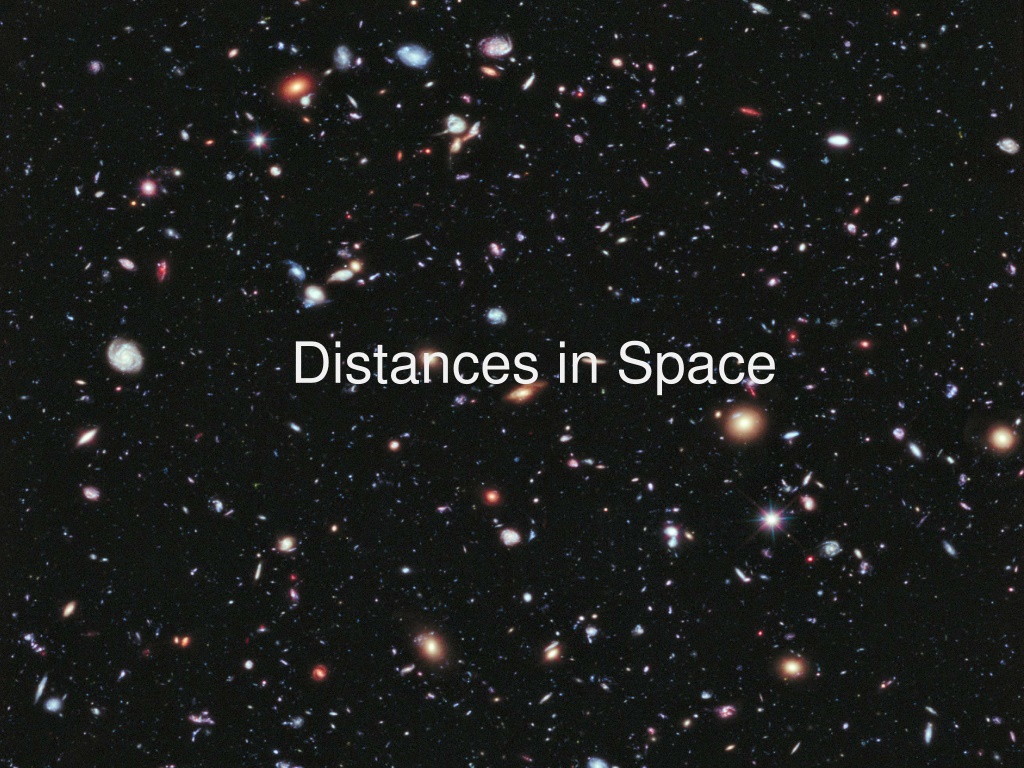

![Read⚡ebook✔[PDF] Linking the Space Shuttle and Space Stations: Early Docking Te](/thumb/21519/read-ebook-pdf-linking-the-space-shuttle-and-space-stations-early-docking-te.jpg)
![READ⚡[PDF]✔ Emerging Space Powers: The New Space Programs of Asia, the Middle Ea](/thumb/21554/read-pdf-emerging-space-powers-the-new-space-programs-of-asia-the-middle-ea.jpg)


